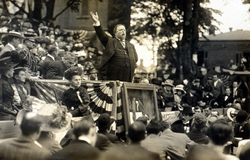Proponents of the statue argue that it commemorates Custer's spectacular service to the Union during the Civil War and not his failure at the Battle of the Little Big Horn. [8] The statue shows Custer wearing his Civil War uniform. In keeping with sculptural convention, his horse has all four feet on the ground, as Custer did not die during that period of service. [7] The historical marker commemorating the statue reads:
Born in New Rumley, Ohio, George A. Custer grew up in Monroe in the home of his half-sister, Mrs. David Reed. On February 9, 1864, in the Presbyterian Church here, he married Libbie Bacon, the only daughter of Judge and Mrs. Daniel S. Bacon. During the Civil War, Custer served with distinction, including at the Battle of Gettysburg. He received six brevets and was made brigadier-general before he was 26 years old, a rare distinction. From 1866 until his death at the Battle of the Little Big Horn, Custer commanded the famous Seventh Cavalry Regiment, leading them in scouting and Indian fighting throughout Kansas and the Dakota Territory. His rank at death was lieutenant colonel, as he reverted to colonel from brigadier general at the end of the Civil War. (He was promoted to lieutenant colonel in 1866, at Ft Riley, Kansas.) This statue of General Custer, created by Edward C. Potter, was erected by the State of Michigan, unveiled by Mrs. Elizabeth B. Custer and dedicated by President William Howard Taft on June 4, 1910. The statue was rededicated September 3, 1955, by the members of the First Cavalry Division, of which Custer's Seventh Cavalry Regiment was a part. [1] [9]






